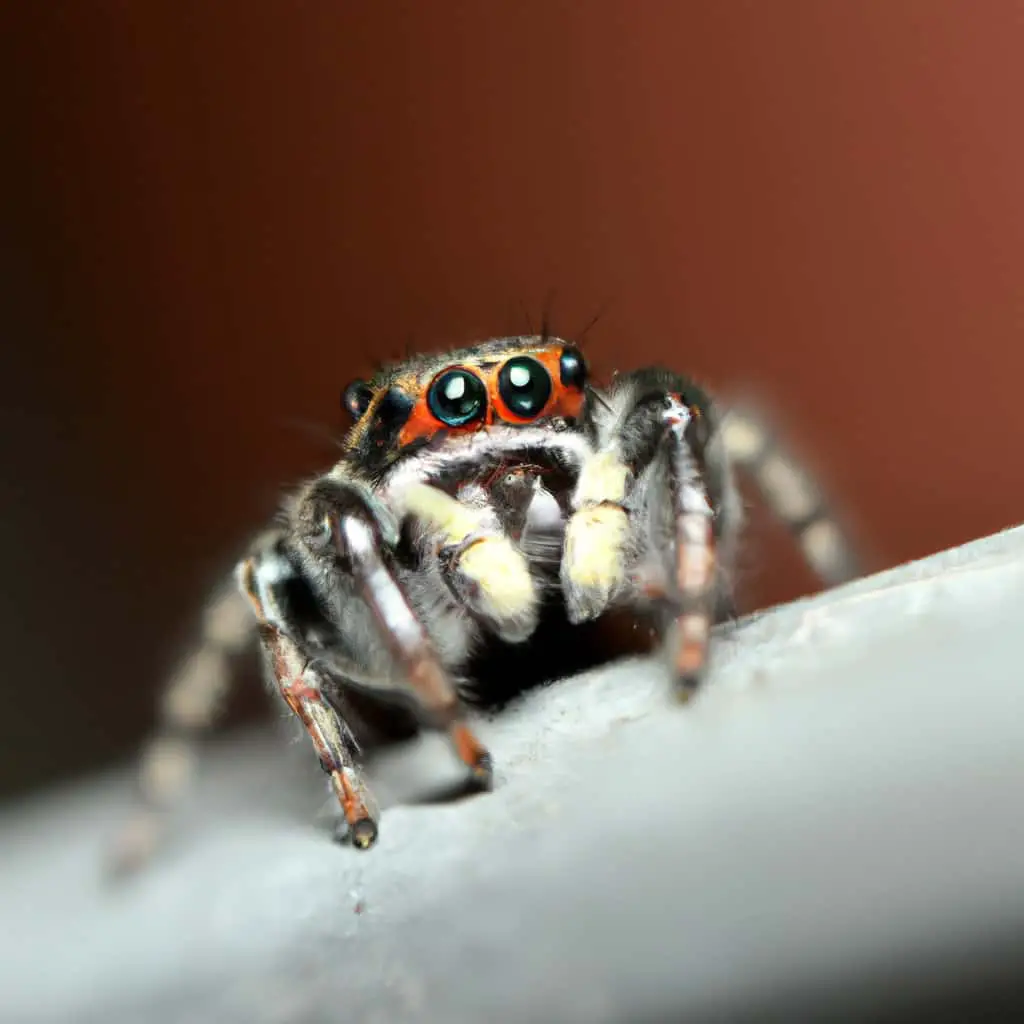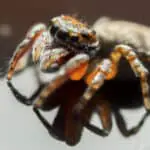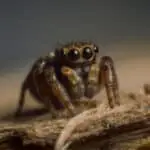Jumping spiders are fascinating creatures that make great pets. They are known for their incredible jumping ability and big, expressive eyes. But what do jumping spiders eat, and how do you feed them? In this article, I will share with you everything you need to know about feeding jumping spiders.
Understanding what jumping spiders eat is crucial to their health and well-being. As carnivorous creatures, they primarily feed on small insects such as flies, crickets, moths, and beetles. They are also known to eat other spiders, including members of their own species, and occasionally even larger prey such as grasshoppers or caterpillars. In the next section, we will dive into more details about feeding jumping spiders and the specific types of insects they should eat.
Key Takeaways
- Jumping spiders are carnivorous and feed primarily on small insects such as flies, crickets, moths, and beetles.
- It is essential to provide your jumping spider with a varied diet to ensure they receive all the necessary nutrients.
- Feeding your jumping spider twice a week with appropriate insects and misting their enclosure weekly will help keep them healthy and happy.

Understanding Jumping Spiders
Jumping spiders are fascinating creatures that belong to the Salticidae family. These spiders are known for their incredible eyesight, agility, and hunting skills. They are also one of the most diverse groups of spiders, with over 5,000 species worldwide.
Jumping spiders are carnivorous, which means they feed on other insects. They are agile hunters that use their excellent eyesight to track and capture their prey. Unlike other spiders, jumping spiders are diurnal, which means they are active during the day and rest at night.
One of the most well-known species of jumping spider is the Phidippus audax, also known as the bold jumping spider. This spider is found throughout North America and is known for its striking appearance and fearless attitude.
Jumping spiders have eight eyes, which provide them with exceptional vision. Their eyes are so advanced that they can see in high resolution and even detect ultraviolet light. This allows them to track and capture their prey with incredible accuracy.
In conclusion, jumping spiders are fascinating creatures that are agile hunters with exceptional eyesight. They are carnivorous and feed on other insects, making them an important part of the ecosystem. Their unique characteristics and behaviors make them a popular choice for pet owners and nature enthusiasts alike.
Habitat and Enclosure
Jumping spiders are fascinating creatures that require a specific habitat and enclosure to thrive. In this section, I will discuss the natural environment of jumping spiders, as well as their needs in captivity.
Natural Environment
Jumping spiders are found in a variety of habitats, including forests, grasslands, and deserts. They prefer areas with plenty of vegetation, as this provides them with both food and shelter. These spiders are diurnal, meaning they are most active during the day, and they need access to plenty of light to thrive.
In the wild, jumping spiders live in temperatures ranging from 68°F to 86°F, and they require a humidity level of around 60-70%. They also prefer a substrate that is moist but not waterlogged.
In Captivity
When keeping jumping spiders in captivity, it’s crucial to provide them with an enclosure that mimics their natural environment as closely as possible. This means providing them with access to plenty of light, as well as maintaining the correct temperature and humidity levels.
A room temperature of around 70°F is ideal for most jumping spiders, and a heat mat is usually not necessary. However, if you live in a particularly cold climate, you may need to provide additional heat to keep your spider healthy.
When it comes to humidity, misting the enclosure daily with water can help maintain the correct levels. You can also use a hygrometer to monitor the humidity and adjust as necessary.
For substrate, a mix of peat moss and vermiculite is ideal, as this provides both moisture and drainage. You can also add some pieces of bark or twigs for your spider to climb on.
When it comes to lighting, a simple LED light can provide the necessary illumination for your jumping spider. However, be sure to avoid exposing your spider to direct sunlight, as this can cause overheating and harm.
In conclusion, providing the right habitat and enclosure is crucial for the health and well-being of your jumping spider. By mimicking their natural environment as closely as possible, you can ensure that your spider thrives in captivity.
Feeding Jumping Spiders
As a spider keeper, feeding your jumping spider is an essential part of ensuring its health and well-being. Jumping spiders are carnivorous and feed primarily on small insects, including flies, crickets, moths, and beetles. They are also known to eat other spiders, including members of their own species, and occasionally even larger prey such as grasshoppers or caterpillars.
Types of Prey
When it comes to feeding your jumping spider, it’s essential to provide a variety of prey to ensure a balanced diet. In the wild, jumping spiders eat a variety of different bugs and insects, and this prey will typically be smaller than the jumping spider itself, though they have been observed taking on prey bigger than themselves. Some of the best feeder insects for your jumping spider include fruit flies, ants, mealworms, small crickets, and house flies.
Feeding Frequency
Compared with larger arachnids, jumping spiders need to eat much more often – ideally two to three times a week. An adult jumping spider could die if it had to go more than a month without food. It’s essential to monitor your spider’s feeding habits and adjust the frequency as necessary. If you notice that your spider is not eating regularly, it could be a sign of stress or illness, and you should consult a veterinarian.
Nutritional Content
When feeding your jumping spider, it’s essential to ensure that the prey you provide is nutritionally balanced. Feeder insects such as fruit flies and mealworms are a good source of protein and other essential nutrients. However, it’s essential to avoid feeding your spider insects that are too large, as this can cause digestive problems. Additionally, it’s essential to avoid feeding your spider insects that have been exposed to pesticides or other harmful chemicals.
In conclusion, feeding your jumping spider is an important part of spider keeping. By providing a variety of prey, monitoring feeding frequency, and ensuring nutritional balance, you can help ensure that your spider remains healthy and happy.
Health and Care
Jumping spiders are generally healthy and easy to care for, but as with any pet, they require proper care to stay healthy and happy. In this section, I will cover the molting process, hydration and misting, observation and interaction, and veterinary care.
Molting Process
Like all arachnids, jumping spiders must molt in order to grow. During this process, they shed their old exoskeleton and grow a new one. Molting can be a stressful time for your pet spider, so it’s important to provide a stress-free environment during this time. Signs that your spider is about to molt include a loss of appetite and a darker color. It’s important to avoid handling your spider during this time, as it may be more fragile than usual.
Hydration and Misting
Jumping spiders require hydration just like any other animal. You can provide a water dish for your spider, but they will also drink from misting. Misting the enclosure once a week will provide the necessary hydration for your spider. Be sure not to mist too much, as excess moisture can lead to mold growth.
Observation and Interaction
Observing and interacting with your jumping spider is one of the joys of owning one of these fascinating pets. You can watch them hunt and jump, and even interact with them by moving your finger around their enclosure. However, it’s important to remember that jumping spiders are delicate creatures and should be handled with care. Always wash your hands before handling your spider, and avoid handling them too much.
Veterinary Care
If you notice any signs of illness or injury in your jumping spider, it’s important to seek veterinary care as soon as possible. Some common signs of illness in spiders include lethargy, loss of appetite, and abnormal behavior. It’s important to find a veterinarian who specializes in exotic pets, as not all veterinarians are trained to treat spiders.
In summary, providing proper care for your jumping spider is essential to keeping them healthy and happy. Be sure to provide hydration, observe and interact with them, and seek veterinary care if necessary. With proper care, your jumping spider can live a long and healthy life in captivity.
Other Considerations
When it comes to feeding your jumping spider, there are a few other things to consider beyond just what to feed them. Here are some additional tips to help you take care of your spider:
Variety
While jumping spiders primarily eat insects, it’s important to provide them with a variety of prey. This can help ensure they receive the necessary nutrients for their growth and development. Consider offering different types of insects such as flies, crickets, moths, and beetles.
Portion Size
When feeding your jumping spider, it’s important to provide them with an appropriate portion size. Overfeeding can lead to obesity and other health issues, so be sure to offer a reasonable amount of food based on the size of your spider.
Frequency
Jumping spiders are diurnal, meaning they are active during the day. As such, it’s best to feed them during the daytime. How often you feed your spider will depend on their age and size. Juvenile spiders will need to eat more frequently than adult spiders.
Nutritional Content
Different types of prey have varying nutritional content. For example, crickets and mealworms have a higher fat content than flies. Consider the nutritional content of the prey you offer to ensure your spider is receiving a balanced diet.
Safe Source
It’s important to ensure the prey you offer your jumping spider is from a safe source. Avoid feeding them wild-caught insects, as these may have been exposed to pesticides or other harmful substances. Instead, purchase prey from a reputable supplier.
Lighting
Lighting can also play a role in your spider’s feeding habits. Jumping spiders are attracted to light, so consider providing a well-lit area for feeding. However, be sure to avoid direct sunlight, as this can be harmful to your spider.
Take Care When Stalking Prey
Jumping spiders are known for their impressive hunting skills, but it’s important to take care when stalking prey. Avoid startling or stressing your spider, as this can lead to health issues. Additionally, be sure to supervise your spider during feeding to ensure they don’t injure themselves while hunting.
Pollen and Sugar
While jumping spiders primarily eat insects, they have been known to consume pollen and sugar in the wild. However, it’s important to offer these foods in moderation, as they are not a natural part of their diet and can lead to health issues if over-consumed.
By following these tips, you can help ensure your jumping spider receives a balanced and healthy diet.
Frequently Asked Questions
What should I feed my jumping spider?
Jumping spiders are carnivorous and primarily feed on small insects such as flies, crickets, moths, and beetles. They are also known to eat other spiders, including members of their own species, and occasionally even larger prey such as grasshoppers or caterpillars. It is important to ensure that the prey is small enough for the spider to handle and not too large to pose a threat to the spider.
How often should I feed my jumping spider?
Feeding jumping spiders every 2-3 days is recommended. Although they can go a week without food, it’s best to feed them as often as you can. Overfeeding is not recommended as spiders do not overeat.
Can jumping spiders eat fruit?
No, jumping spiders cannot eat fruit. They are strictly carnivorous and require a diet of live insects.
Can jumping spiders eat rolly pollies?
No, jumping spiders cannot eat rolly pollies. They are not a suitable prey for jumping spiders, and feeding them to your spider can be harmful.
Can I feed my jumping spider dead bugs?
No, it is not recommended to feed your jumping spider dead bugs. Jumping spiders prefer live prey and may not recognize dead bugs as food. Feeding them dead bugs can also pose a risk of bacterial or fungal infections.
How to get a jumping spider to trust you?
Jumping spiders are naturally curious and may approach you if they feel safe and comfortable. You can build trust by providing a stable and comfortable environment for your spider, avoiding sudden movements, and offering food consistently. However, it is important to remember that jumping spiders are still wild animals and may not necessarily become fully domesticated.







